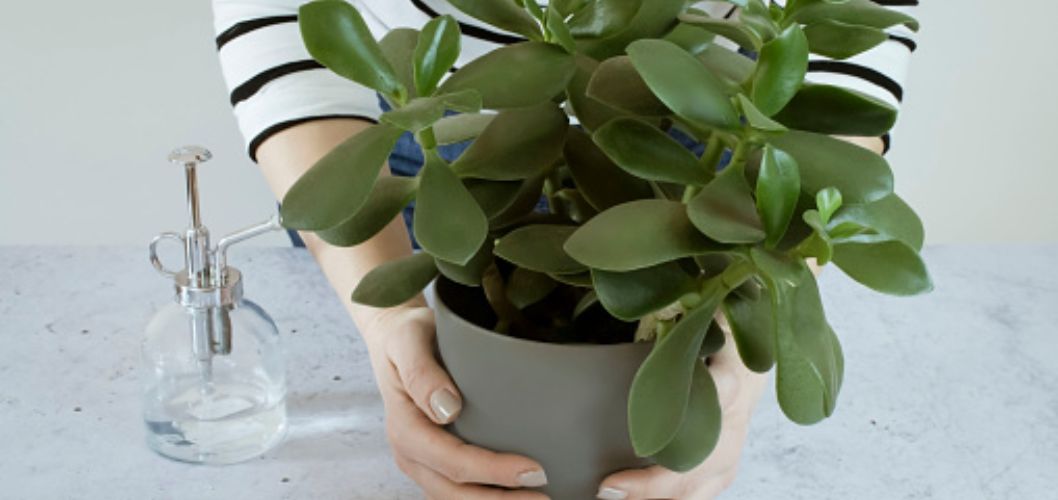Jade plants (Crassula ovata), also known as money trees or friendship trees, are popular succulents renowned for their attractive appearance and low-maintenance nature. With their vibrant green, thick, fleshy leaves and a tree-like structure, these plants can bring a touch of elegance to any indoor or outdoor space. Whether you’re a seasoned plant enthusiast or a beginner looking to develop your green thumb, this comprehensive guide will provide you with all the information you need to successfully grow and care for jade plants.
How to Care for Jade Plants
Choosing the Right Environment
Jade plants thrive in bright, indirect light, making them suitable for both indoor and outdoor settings. When selecting an indoor location, place your jade plant near a window with filtered sunlight or in a well-lit room. Outdoors, a spot with partial shade is ideal to protect the plant from intense sunlight.
Soil and Potting
Jade plants prefer well-draining soil to prevent root rot. A mix of regular potting soil and perlite or coarse sand works well. Ensure that the chosen pot has drainage holes to prevent waterlogging. It’s best to repot jade plants every two to three years to provide fresh soil and adequate space for growth.
Watering
Jade plants are succulents and are adapted to survive in arid conditions. Therefore, they have low water requirements. Allow the soil to dry out partially between watering, as overwatering can lead to root rot. Stick your finger about an inch into the soil; if it feels dry, it’s time to water. Be cautious during winter, as jade plants require even less water due to reduced growth.
Temperature and Humidity
Jade plants prefer average room temperatures between 65°F to 75°F (18°C to 24°C). They can tolerate slightly cooler temperatures but are sensitive to frost. Maintain a humidity level of 40% to 50%, which is typical for most indoor environments. Avoid placing the plant near drafts or sudden temperature changes.
Fertilization
Jade plants have moderate fertilization requirements. During the growing season (spring and summer), use a balanced, water-soluble fertilizer at half the recommended strength every four to six weeks. In the dormant season, reduce or halt fertilization as the plant’s growth slows down.
Pruning and Shaping
Pruning is essential to maintain the desired shape and size of your jade plant. Trim leggy or overgrown branches to promote compact growth. Prune in early spring to allow for new growth during the active growing season. Use clean, sharp pruning shears to prevent the spread of diseases.
Propagation
Jade plants are relatively easy to propagate. The most common method is through stem or leaf cuttings. Select a healthy stem or leaf, let it callous over for a few days, and then plant it in a well-draining soil mix. Water sparingly until roots form. Alternatively, you can propagate using leaf or stem sections directly planted in moist soil.
Common Issues and Pests
Jade plants are generally resistant to pests and diseases. However, overwatering can lead to root rot, while underwatering may cause leaves to shrivel. Watch out for mealybugs, aphids, and scale insects. Use a gentle insecticidal soap or neem oil to treat infestations, if necessary.

Potting and Repotting Jade Plants
Potting and repotting jade plants are important aspects of their care routine. Proper potting ensures good drainage and allows the plant to establish a healthy root system. Here’s a step-by-step guide on how to pot and repot your jade plant:
Selecting the Right Pot
Choose a pot that is slightly larger than the current one, allowing room for the plant’s growth. Ensure that the pot has drainage holes at the bottom to prevent waterlogging.
Choosing the Soil Mix
Jade plants prefer well-draining soil to prevent root rot. A suitable soil mix consists of regular potting soil combined with perlite or coarse sand. This mixture promotes drainage while retaining some moisture.
Potting Process
- Start by placing a layer of small stones or broken pot shards at the bottom of the new pot. This helps facilitate drainage and prevents the soil from clogging the drainage holes.
- Fill the pot with the prepared soil mix, leaving enough space for the plant’s root ball.
- Gently remove the jade plant from its current pot. You can tap the pot’s sides or use a gentle twisting motion to loosen the plant’s roots.
- Place the plant in the new pot, ensuring that it sits at the same depth as before. The soil line should be slightly below the rim of the pot.
- Fill the remaining space with the soil mix, lightly pressing it down around the roots. Avoid compacting the soil too tightly.
Post-Potting Care
- Water the newly potted jade plant thoroughly. This helps settle the soil and eliminates any air pockets around the roots.
- Allow excess water to drain out completely, and empty the saucer to prevent the plant from sitting in standing water.
- Place the newly potted jade plant in its preferred location with bright, indirect light.
Repotting
Jade plants generally require repotting every two to three years to provide fresh soil and adequate space for growth. Signs that your jade plant needs repotting include roots growing out of the drainage holes, stunted growth, or if the plant becomes top-heavy.
- Choose a slightly larger pot than the current one, following the same steps mentioned above for potting.
- Before repotting, gently loosen the soil around the root ball to encourage new growth and ease the transition into the new pot.
- Trim any damaged or excessively long roots during the repotting process.
- Follow the potting process outlined above to ensure the plant is properly potted in the new container.
Remember, jade plants prefer being slightly root-bound, so avoid using excessively large pots. Repotting is best done in the spring or early summer when the plant is actively growing.
